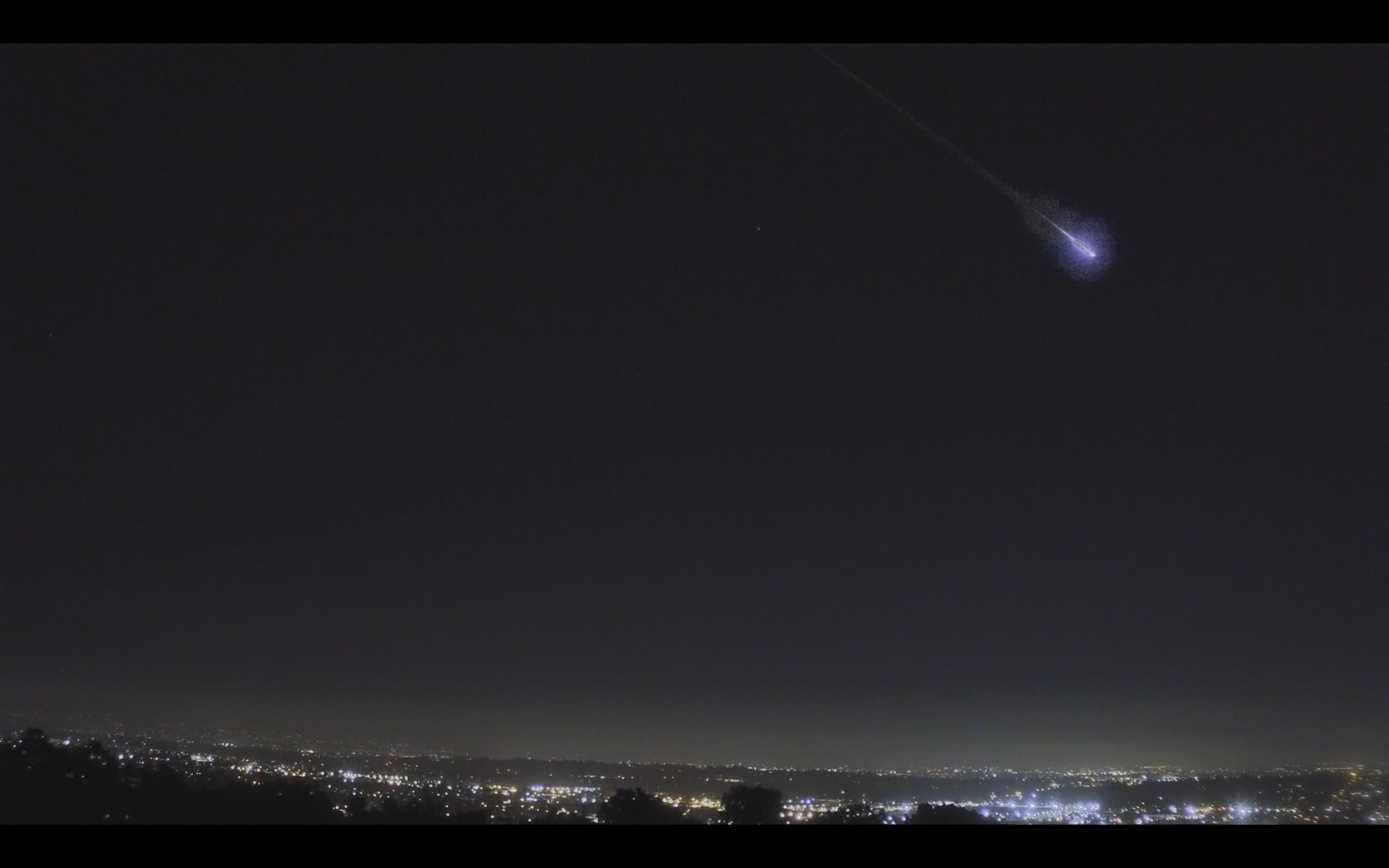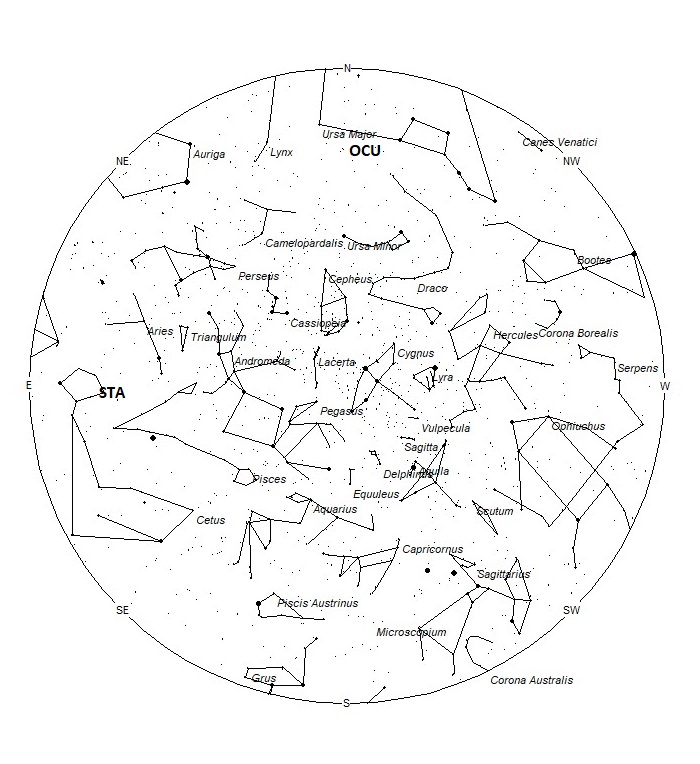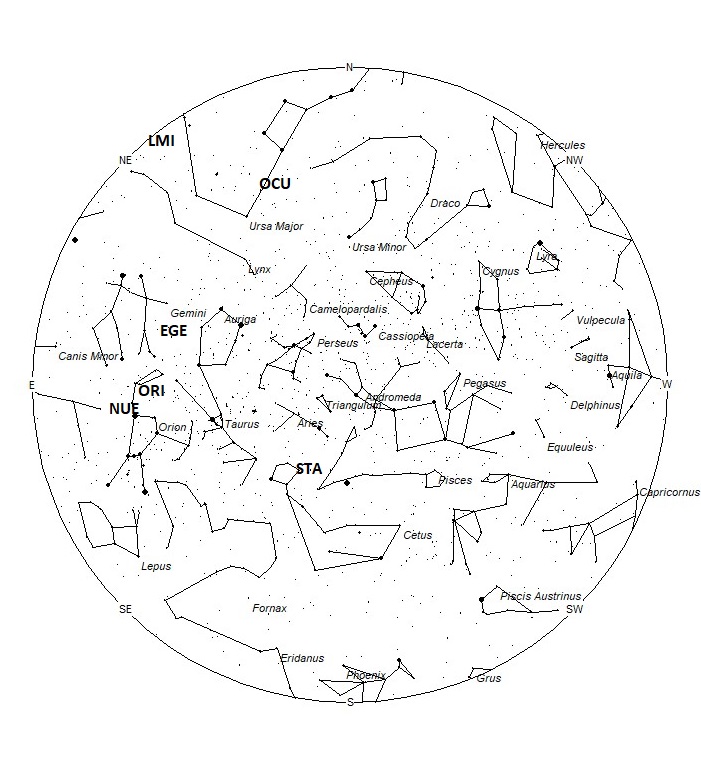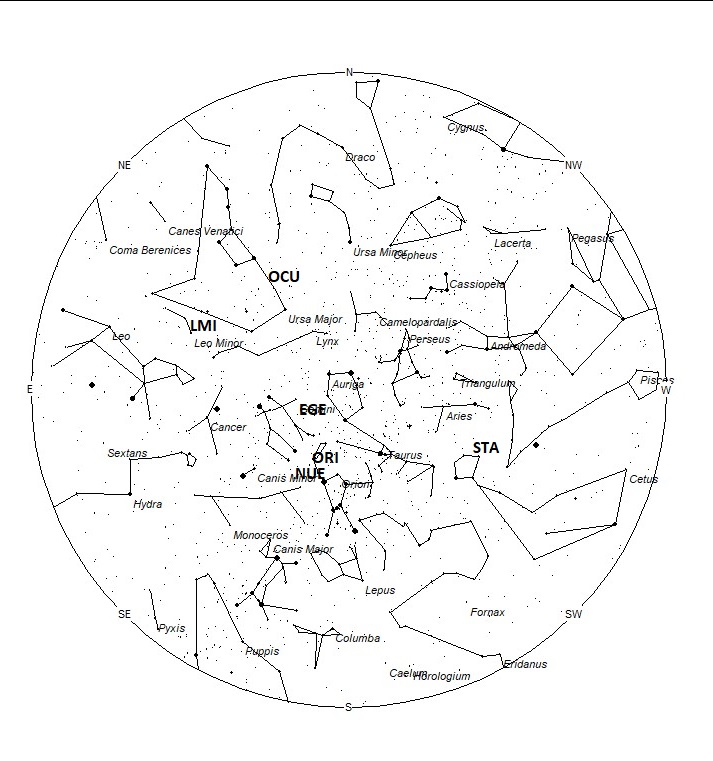
During this period, the moon reaches its new phase on Friday October 16th. At that time, the moon is located near the sun and is invisible at night. This weekend the waning crescent moon will rise during the early morning hours but will not interfere with meteor observing as long as your keep it out of your field of view. The estimated total hourly meteor rates for evening observers this week is near 4 as seen from mid-northern latitudes and 3 as seen from tropical southern locations (25S). For morning observers, the estimated total hourly rates should be near 16 as seen from mid-northern latitudes (45N) and 11 as seen from tropical southern locations (25S). Morning rates are reduced due to moonlight. The actual rates will also depend on factors such as personal light and motion perception, local weather conditions, alertness, and experience in watching meteor activity. Note that the hourly rates listed below are estimates as viewed from dark sky sites away from urban light sources. Observers viewing from urban areas will see less activity as only the brighter meteors will be visible from such locations.
The radiant (the area of the sky where meteors appear to shoot from) positions and rates listed below are exact for Saturday night/Sunday morning October 10/11. These positions do not change greatly day to day so the listed coordinates may be used during this entire period. Most star atlases (available at science stores and planetariums) will provide maps with grid lines of the celestial coordinates so that you may find out exactly where these positions are located in the sky. A planisphere or computer planetarium program is also useful in showing the sky at any time of night on any date of the year. Activity from each radiant is best seen when it is positioned highest in the sky, either due north or south along the meridian, depending on your latitude. It must be remembered that meteor activity is rarely seen at the radiant position. Rather they shoot outwards from the radiant, so it is best to center your field of view so that the radiant lies at the edge and not the center. Viewing there will allow you to easily trace the path of each meteor back to the radiant (if it is a shower member) or in another direction if it is a sporadic. Meteor activity is not seen from radiants that are located far below the horizon. The positions below are listed in a west to east manner in order of right ascension (celestial longitude). The positions listed first are located further west therefore are accessible earlier in the night while those listed further down the list rise later in the night.
These sources of meteoric activity are expected to be active this week.
.
The Southern Taurids (STA) are active from a large radiant centered at 02:13 (033) +10. This area of the sky is located on the Cetus/Aries border, just 1 degree northeast of the 4th magnitude star known as Xi1 Ceti. This source is best placed near 0200 local daylight saving time (LDST) when it is located highest in the sky. Current hourly rates would be near 2 no matter your location. With an entry velocity of 27 km/sec., most activity from this source would possess slow velocities.
The Orionids (ORI) are active from a radiant located at 05:58 (089) +15. This area of the sky lies in northeastern Orion, 2 degrees west of the 4th magnitude star known as nu Orionis. This position also lies 8 degrees north of the bright orange star known as Betelgeuse (alpha Orionis). The radiant is best placed near 0600 LDST, when it lies highest above the horizon. Current hourly rates would be near 4 per as seen from the northern hemisphere and 3 as seen from south of the equator. With an entry velocity of 66 km/sec., most activity from this radiant would be of swift velocities.
The nu Eridanids (NUE) were co-discovered by Japanese observers using SonotoCo and Juergen Rendtel and Sirko Molau of the IMO. Activity from this long-period stream stretches from August 24 all the way to November 16. Maximum activity occurred on September 24th. The radiant currently lies at 06:13 (093) +10, which places it in northeastern Orion, 4 degrees northeast of the 1st magnitude star known as Betelgeuse (alpha Orionis). This is close to the Orionid radiant and care must be taken to separate the two when observing. This area of the sky is best seen during the last dark hour before dawn when the radiant lies highest in a dark sky. Current rates are expected to be near 1 per hour during this period no matter your location. With an entry velocity of 67 km/sec., the average meteor from this source would be of swift velocity.
The epsilon Geminids (EGE) are active from September 30 through October 25 with maximum activity occurring on October 11. The radiant is currently located at 06:15 (094) +28, which places it on the Auriga/Gemini border, 2 degrees north of the 4th magnitude star known as kappa Aurigae. This area of the sky is best placed in the sky during the last hour before dawn, when it lies highest above the horizon in a dark sky. Current rates would be near 2 per hour as seen from the northern hemisphere and near 1 as seen from southern of the equator. With an entry velocity of 70 km/sec., most activity from this radiant would be of swift velocities.
The October Ursa Majorids (OCU) are a recent discovery by the Japanese group known as SonotaCo. These meteors are only active for 3 nights centered on October 15th. The radiant is located at 09:40 (145) +65. This position lies in northwestern Ursa Major. The nearest star of note is 23 Ursae Majoris, which lies 3 degrees southwest of the radiant. See the charts for a better idea of the location of this source. This area of the sky is best placed in the sky during the last hour before dawn, when it lies highest above the horizon in a dark sky. Current rates would be most likely less than 1 per hour no matter your location. With an entry velocity of 56km/sec., most activity from this radiant would be of swift speed.
The Leonis Minorids (LMI) are active from October 12-Nov 5 with maximum activity occurring on October 23rd. This radiant is currently located at 09:55 (149) +41, which places it in northern Leo Minor, 4 degrees southwest of the pair or 3rd magnitude stars known as mu and lambda Ursae Majoris. The radiant is best placed just before dawn when it lies highest in a dark sky. This shower is better situated for observers situated in the northern hemisphere where the radiant rises far higher into the sky before the start of morning twilight. Current rates would be less than 1 no matter your location. At 62km/sec., the average Leonis Minorid is swift. From my personal experience this minor shower produces a high proportion of bright meteors.
As seen from mid-northern hemisphere (45N), sporadic morning rates would be near 8 per hour as seen from rural observing sites and 3 per hour during the evening hours. As seen from the tropical southern latitudes (25S), one would expect to see approximately 5 sporadic meteors per hour during the last hour before dawn as seen from rural observing sites. Evening rates would be near 2 per hour. Locations between these two extremes would see activity between the listed figures. Morning rates are reduced during this period due to moonlight.
The list below offers the information from above in tabular form. Rates and positions are exact for Saturday night/Sunday morning except where noted in the shower descriptions.
| SHOWER | DATE OF MAXIMUM ACTIVITY | CELESTIAL POSITION | ENTRY VELOCITY | CULMINATION | HOURLY RATE | CLASS |
| RA (RA in Deg.) DEC | Km/Sec | Local Daylight Saving Time | North-South | |||
| Southern Taurids (STA) | Nov 03 | 02:13 (033) +10 | 27 | 02:00 | 2 – 2 | II |
| Orionids (ORI) | Oct 21 | 05:58 (089) +15 | 66 | 06:00 | 4 – 3 | I |
| nu Eridanids (NUE) | Sep 24 | 06:13 (093) +10 | 67 | 06:00 | 1 – 1 | IV |
| epsilon Geminids (EGE) | Oct 11 | 06:15 (094) +28 | 70 | 06:00 | 1 – <1 | II |
| October Ursa Majorids (OCU) | Oct 15 | 09:40 (145) +65 | 56 | 10:00 | <1 – <1 | IV |
| Leonis Minorids (LMI) | Oct 23 | 09:55 (149) +41 | 62 | 10:00 | <1 – <1 | II |
 American Meteor Society
American Meteor Society



Wow,,,I am on my way to see what I can. Thanks
Sherry
So. Oregon coast
Will I be able to see anything from the Santa Barbara mountains tonight, October 15th? Or should I wait until tomorrow? Thank you!
Jessica and All,
You can see meteor activity on any night that the moon is not shining bright. Tonight would be fine but rates will slowly increase as we approach the maximum of the Orionid meteor shower next Tuesday night/Wednesday morning. I was out for 3 hours this morning and counted 19 meteors from my suburban location. You should be able to see more from a darker, rural location.
I am pretty sure a huge meteor went by about 8pm near Detroit, MI. It went West and parallel to the surface. It looked very large.
Taylor and All,
We have received one other report of your fireball. You can see the event site for this fireball at: https://fireball.amsmeteors.org/members/imo_view/event/2020/5880 Click on the other witnesses’ name to read the comments they made.
Can I see a meteor shower or shooting stars today,17 October ? I have one more question that I have saw something which entered the earth atmosphere and coming down slowly. So , please can you reply me about that object
Oct 17, 2020 – Maryland
Had to look this up because I went outside this afternoon and noticed something on fire falling out of the sky. Once I found out it was a meteor shower we sat outside for over an hour just watching them. I lost count after 10. Highlight of quarantine. Excited for the Peak.